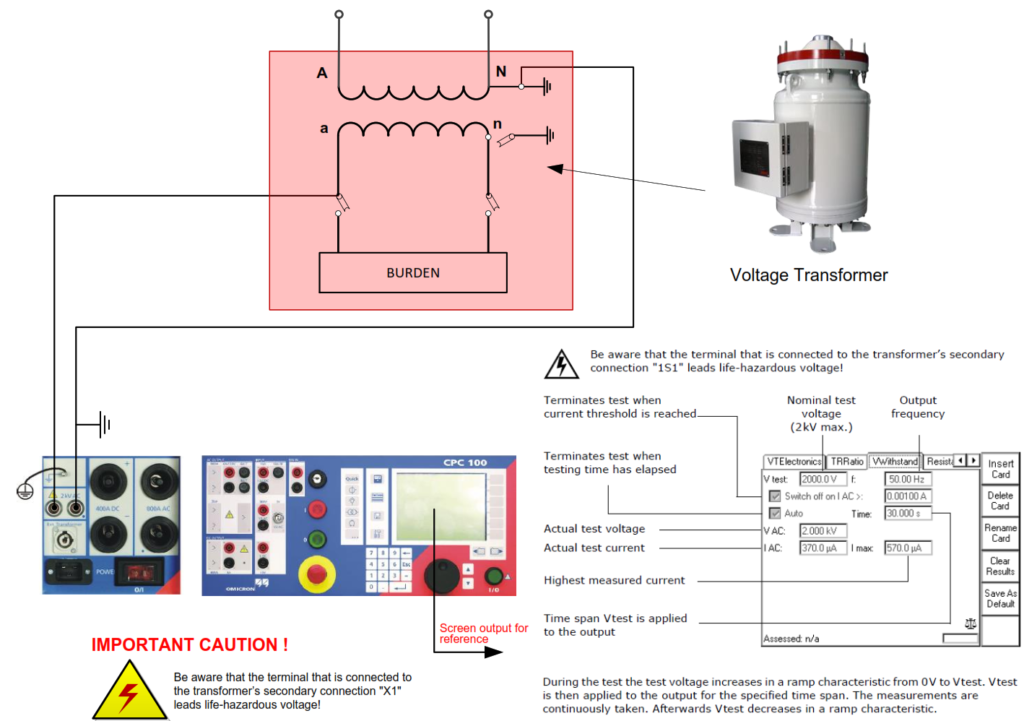This article is guide to the responsible persons in conducting Voltage Transformer Voltage Withstand Test.
SAFETY PRECAUTIONS – The following Safety precautions shall be taken in consideration prior, during and after conducting the test measurements.
- Safety tagging shall be implemented.
- Isolate the Area by Safety Warning Tape.
- Keep a Safe Distance from the device being tested.
- Wear Appropriate Personal Protective Equipment(PPE) Prior to starting any testing activity.
- Implementation of Proper Grounding.

TEST EQUIPMENTS: OMICRON CPC-100
Voltage Withstand Test Procedure
- Setup the CALIBRATED test instrument in a firm, reasonably level base and dry area.
- Identify test parameters and terminals for proper connections.
- Set-up and effectively ground the test instrument. Supply voltage, 110Vac or 230Vac. Conduct testing as per the following illustrated test Connections:

- Power ON the Test Instrument and select VWithstand Test Card
- Properly fill-up test settings:
- Press I/O (test start/stop) push-button to start the test.
- Save test card for printing.
7.1 For multi-tap core/s, create and save test card for each tap tested. - Note and record all necessary test parameters in standard test forms
- Evaluate test result as per general standard ratings.
What is Voltage Withstand Test?
A Voltage Withstand Test, also known as a Dielectric Withstand Test or Hipot Test (High Potential Test), is a type of electrical test conducted to assess the insulation integrity of electrical equipment and ensure its ability to withstand high voltage levels without breakdown or failure. The primary purpose of this test is to verify the dielectric strength of insulation, helping to identify potential weaknesses or faults that could lead to electrical breakdown.
What is Purpose of voltage withstand test?
The main objective is to determine whether the insulation in electrical equipment can withstand higher-than-normal operating voltages without experiencing a breakdown.
It helps ensure the safety and reliability of the equipment by confirming that the insulation is capable of isolating live conductors from the equipment’s external surfaces.
It helps ensure the safety and reliability of the equipment by confirming that the insulation is capable of isolating live conductors from the equipment’s external surfaces.
What is procedure of voltage withstand test?
The test involves applying a higher-than-normal voltage to the equipment for a specified duration.
The voltage is gradually increased to a predetermined level and held for a specific period to simulate abnormal operating conditions.
The test is considered successful if the equipment withstands the applied voltage without excessive current leakage or breakdown.
The voltage is gradually increased to a predetermined level and held for a specific period to simulate abnormal operating conditions.
The test is considered successful if the equipment withstands the applied voltage without excessive current leakage or breakdown.
What equipment is used in voltage withstand test?
A Hipot Tester or Dielectric Strength Tester is used to perform the test.
The tester generates high voltage and measures the leakage current.
The tester generates high voltage and measures the leakage current.
What are test parameter for voltage withstand test?
The test voltage and duration are determined based on industry standards, equipment specifications, or applicable regulations.
The voltage level is often significantly higher than the normal operating voltage but within a safe range that won’t damage the equipment.
The voltage level is often significantly higher than the normal operating voltage but within a safe range that won’t damage the equipment.
What are safety considerations for voltage withstand test?
Due to the high voltages involved, safety precautions are critical.
Proper isolation, protective barriers, and safety equipment are used to ensure the safety of the personnel conducting the test.
Proper isolation, protective barriers, and safety equipment are used to ensure the safety of the personnel conducting the test.
What is acceptance criteria for voltage withstand test?
The acceptance criteria for the test are defined by industry standards, equipment specifications, or relevant regulations.
Typically, the equipment should not exhibit excessive current leakage or breakdown during the test.
Typically, the equipment should not exhibit excessive current leakage or breakdown during the test.
When frequently perform the test?
Voltage Withstand Tests are often performed during the manufacturing process, routine maintenance, or after repairs.
Periodic testing ensures ongoing integrity of the insulation.
Periodic testing ensures ongoing integrity of the insulation.